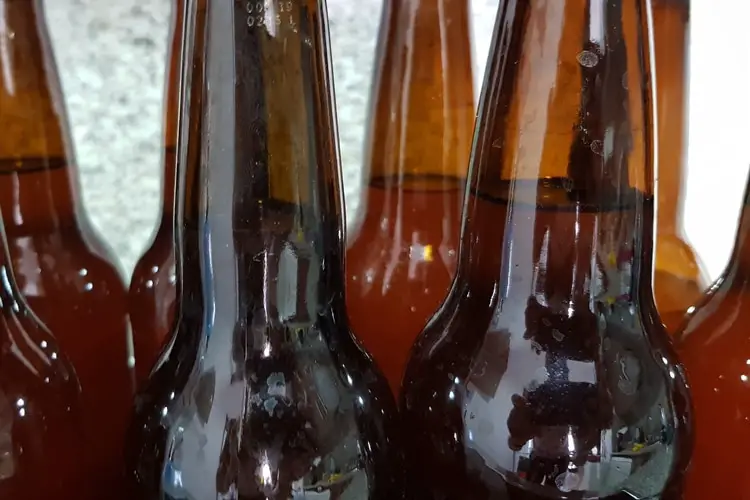Part of the fun of brewing your own beer at home is experimenting with the variables to change up your results. If you’re thinking of how to increase the alcohol content in your next batch, there are several ways to achieve this. I’ll review a few of the options along with their pros and cons below.
The most common way to make a homebrew beer stronger is to add some sort of sugar. You can combine this with other strategies like increasing yeast or fermentation time to get your desired result.
As with all homebrews, be aware that any alterations you make to the original recipe will change the flavor of your beer, and not always for the better.
Make sure you’re comfortable with the basics of homebrewing before you start exploring new techniques.
What Determines Alcohol Content?
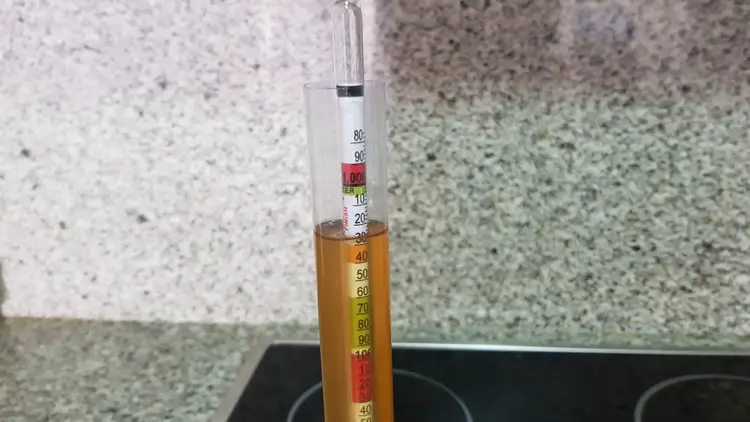
A typical beer will range between 4.0 to 7.0 percent ABV, although they can be as high as 25.0 percent ABV on the extreme high end (or even higher but I’m not sure if we should still consider this beer).
For comparison, liquor is usually between 15.0 percent to 50.0 percent ABV.
Any beer above 7% alcohol would be considered a high alcohol beer.
You can calculate the rough ABV of your homebrew by using a simple formula and plugging in your original gravity reading and your final gravity reading, taken before bottling.
The formula is:
ABV = (OG – FG) * 131.25, where:
- ABV = alcohol by volume
- OG = original gravity
- FG = final gravity
You can use this handy ABV calculator in case you prefer not to do the math yourself.
The amount of alcohol in your homebrew can be determined by the amount of fermentable sugars and the type of yeast used, although a few other factors also contribute.
When the yeast consumes the fermentable sugars during the brewing process, the result is ethanol – the alcohol in alcoholic beverages.
More ethanol produced during fermentation means a higher alcohol content.
10 Effective Ways to Make a Homebrew Beer Stronger
Making homebrew beer stronger involves increasing the ethanol content via one or more of the methods below.
Simply put, you’ll want to increase the amount of food available for the yeast to process, increase the amount of yeast, or increase the length of time for the yeast to do its work.
1) Sugar
Does adding sugar make homebrew beer stronger?
The short answer to this question is yes, adding sugar to your homebrew beer is the most common and effective way to make it stronger.
But it’s a bit more nuanced than that since you have a variety of sugars available that will each have a different effect on the result.
Although hearing the word sugar probably brings to mind the white granulated sugar that we use to make cookies or sweeten tea, the scientific definition of sugars is much broader than that.
A sugar actually describes a category of carbohydrates found in plants or milk, distinguished by its sweet taste.
There are different types of sugars made up of either a single molecule or multiple molecules bound together.
We’ll look at a few different types of sugars below and discuss how each one can be used in your homebrew.
Types of sugars used in brewing:
- White and brown sugars
- Syrups and syrup solids
- Natural liquid sugars
- Brewers crystals
- Malt extracts
Keep in mind that if you’re brewing with any fruits, they also contain natural sugars and will have an impact on your final alcohol content. Account for those naturally-occurring sugars when considering what to add during the brewing process.
Each type of brewing sugar will be broken down differently as the yeast processes it into glucose and fructose.
Depending on the percentages of each in your wort, the fermentation process will vary.
In addition to increasing the ABV, adding more sugar to your homebrew can change the flavor, color, and body of the beer.
Adding White Sugar to Homebrew Beer

The obvious advantage of using “regular” sugar of any type for your homebrew is its easy availability.
You can purchase varieties of dry or liquid sugars at a supermarket, sparing you the trouble of ordering by mail or visiting a specialty store.
Depending on your desired flavor profile, you can choose a sugar that complements the type of beer you’re brewing.
White sugar is not usually used in brewing, although it can increase the beer’s gravity and alcohol content.
It’s best used in small amounts since using too much can cause you to end up with an overly sweet batch that’s more like cider.
There’s some disagreement among homebrewers as to whether it is “bad” to use white sugar. However, there does seem to be a consensus that other brewing sugars are equally helpful in raising alcohol content while they also add flavor that white sugar doesn’t.
In summary, white sugar:
- Lightens color
- Increases bitterness
- Increases dryness
- Decreases body
Adding Brown Sugar to Homebrew Beer
Brown sugars, including light brown sugar, dark brown sugar, turbinado, molasses, and treacle, vary in color depending on the amount of molasses content.
Darker brown sugars are best used in dark beers such as brown ales, porters, and stouts since their flavor can easily overpower lighter beers.
As with white sugar, brown sugar products are easy to obtain in regular grocery stores.
In summary, brown sugar:
- Darkens color slightly
- Increases sweetness
- Adds bitterness (especially darker varieties)
- Adds fruity, caramel, rum, molasses flavors
- Decreases body
2) Malt Extract
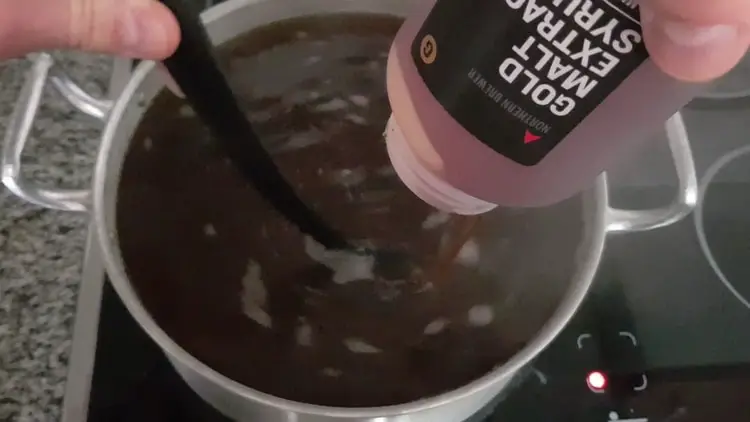
Malt extract is made from malted barley that is mixed with water and then heated to form a sweet liquid wort, then evaporated to a syrup or a powder.
It’s the most recommended source of sugar for homebrewers looking to increase alcohol content without adding sweetness to their beer.
You can purchase malt extract from homebrew suppliers or on Amazon either as a liquid or a powder, called liquid malt extract (LME) or dry malt extract (DME), respectively.
Whether you choose to use LME or DME will depend on a couple of factors.
Liquid malt extract has the advantage of dissolving easily compared with dry malt extract, and LME is generally thought to have a better flavor.
However, it can change color and degrade if it’s not used right away.
On the other hand, DME is considered to have a longer shelf life and keep its color better than LME. It’s easier to measure and store.
However, it can clump or become gummy in water or even in humid conditions.
DME creates a slightly higher gravity compared to LME when used in the same proportions.
Regardless of which type you choose, increasing the amount of malt extract in your beer will give you a better flavor and improve the alcohol content at the same time.
You can also purchase malt extracts in a range of colors and flavor profiles to suit the type of homebrew you’re making.
Using specialty malts counteracts the thinning you can get with other sugars.
In summary, malt extracts:
- Darken color
- Produce a pleasant malty flavor
- Increase alcohol content
- Increase body
- Increase alcohol warmth
- Reduce bitterness
- Have a higher finishing gravity
3) Syrups and Syrup Solids
Specialty sweeteners made from corn and rice are available from homebrew suppliers, and like other forms of sugar can be used to increase the ABV in your homebrew.
They come in both syrup and syrup solid form.
These types of syrups are quickly fermentable.
Syrups and syrup solids are most suitable as adjuncts for a light ale or lager since they result in a clear, light-bodied beer.
You should not expect any sort of corn or rice flavor to come through from these syrups, as their purpose is not to add flavor.
Other options on this list are better for increasing alcohol content, along with adding to the complexity of taste.
As with the sugars mentioned above, be careful with the number of syrups or syrup solids you add, since they can lead to undesirable flavors if overused.
In summary, syrups, and syrup solids:
- Darken color
- Decrease body
- May caramel, honey flavors
Belgian Candi Syrups and Sugars
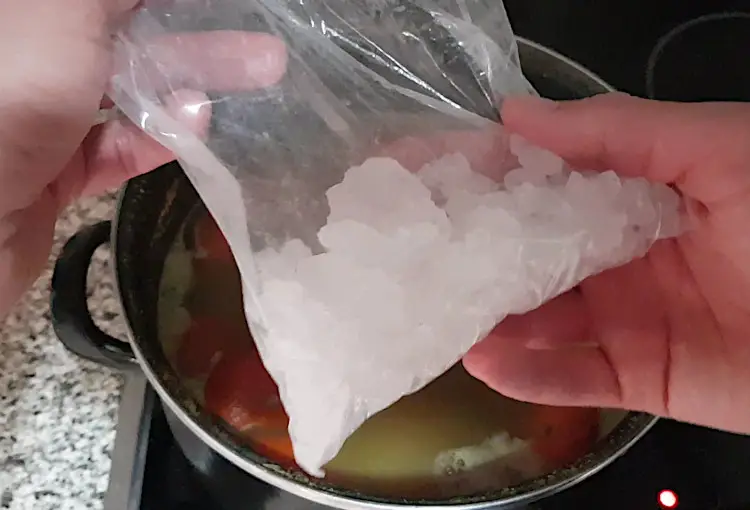
An alternative to corn or rice syrup would be Belgian Candi syrup and sugar.
Made from sugar beets, these sweeteners are specialty products designed for brewing strong Belgian beers and provide a high alcohol content without adding extra body.
Note that candi sugars come in light and dark varieties, with the darker ones imparting more flavor notes and more body.
As with brown sugar, choose your candi sugar to complement the type of beer you’re brewing.
Darker candi syrup can give you color results like roasted malts, but with entirely different flavor profiles.
You can read more about candi sugars in this article, which details the types and nuances of these specialty sugars.
In summary, Belgian Candi syrups and sugars:
- Darken color (dark varieties)
- Decrease body
- May add toffee, fruit flavors
4) Honey & Other Natural Liquid Sugars
Natural liquid sugars like maple syrup, agave, and honey can be used to increase ABV and lend specific characteristics to your beer.
Honey raises the alcohol content and lightens the body.
Surprisingly, you may not find any traces of the honey flavor or residual sweetness when your beer is complete.
That’s because the sugars in honey are 95% fermentable.
Honey also is sometimes known to add some floral notes to the beer and remove some bitterness.
Note that there are many varieties of honey, depending on the location where it’s made and the types of pollen available there.
Color and flavor can vary widely, and some characteristics are known to come through in beer while others disappear without a discernible taste.
Like honey, maple syrup can be used in place of or in addition to other sugars in your homebrew. It will increase both gravity and ABV and may add a hint of maple flavor. However, if your goal is to get a noticeable maple flavor in your beer, using maple extract will give you a more concentrated flavor.
Agave nectar is a natural syrup made from blue agave plants, which are best known for their role in making tequila. As with maple syrup and honey, you may get a minor flavor change with the addition of agave, but it will not be a strong note within your flavor profile.
Note also that natural liquid sugars can take a long time to ferment, which could result in your beer becoming overly sweet or over-carbonated.
Overall, if your main goal is to raise the ABV in your homebrew, natural liquid sugars are probably not the best choice, although they will get the job done.
They’re more expensive than options like malt extracts or syrup solids, but don’t generally change the flavor in very noticeable ways.
In summary, honey, and other natural liquid sugars:
- Darken color
- Decrease body
- Increase dryness
- May add subtle floral or maple flavors
5) Brewers’ Crystals
Brewers’ Crystals are made from a combination of corn syrup and glucose solids, specifically for beermakers.
They mimic the effects of malt extract – just made of corn instead of barley – and can maintain the flavor and body of the original recipe while increasing the alcohol content.
Use brewers’ crystals when you want to increase gravity and ABV without adding flavor.
6) Sugar Substitutes
You might be tempted to use an artificial sweetener like Stevia, aspartame, or xylitol, either because it’s what you have on hand or for health reasons.
Unfortunately, yeasts do not ferment sugar substitutes, so they don’t create ethanol in beer.
It would be possible to use a sugar substitute to sweeten a beer but not to produce alcohol.
7) Extra Yeast
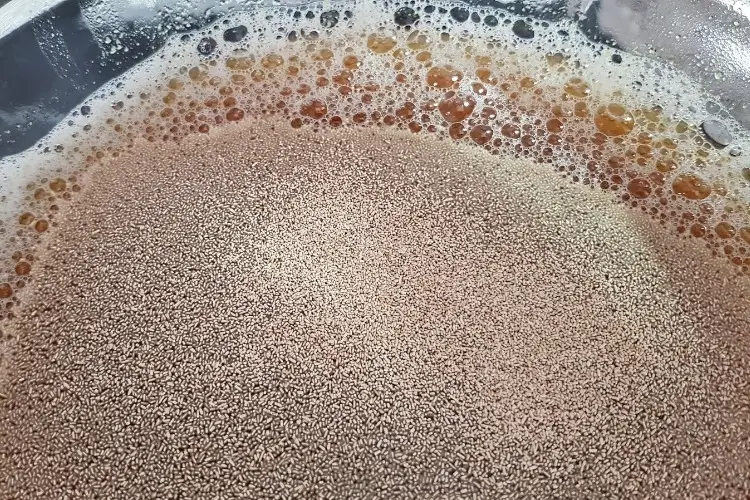
Knowing that ABV depends on yeast that converts sugars into alcohol, a logical next thought would be that you’ll need more yeast to process those extra sugars.
But, does extra yeast make homebrew beer stronger?
Excess alcohol can indeed kill off your yeast, so you might try to counteract that by adding extra yeast and/or yeast nutrients. If you’re trying to go for higher alcohol content (10% or higher), it’s a good idea to invest in a brewer’s yeast that is designed for high alcohol tolerance.
You have two options during the brewing process to add extra yeast.
You can add the yeast early on by incorporating it into the wort, which will make for a more extended fermentation period (also creating a higher ABV).
Alternately you can add your high alcohol tolerance yeast and yeast nutrients toward the end of the fermentation process to reactivate your mixture.
Instead of just thinking of more yeast, you should also be sure you’re using the right yeast type for your homebrew.
Some strains may not have the tolerance to produce as much alcohol as you’re hoping for.
If they are overwhelmed by excess alcohol, the yeast could become stressed and not behave the way you’re expecting, or they can create off-flavors.
Adding extra yeast does make beer stronger, but it works best in combination with adding more brewing sugars.
8) Finely Ground Grains
If you are lautering your own grains, you can adjust how coarsely they are ground to manipulate the resulting alcohol content.
During the brewing process, sugar will be more easily extracted from a fine grind than a coarse one. However, be careful not to go overboard with your grinding since that will create a sticky mess when sparging.
You want to have a mix of course and fine grains left to allow water to flow through without clogging.
There should be little flour, and the husk should be separated from the kernel.
Of course, if you’re using a kit that comes with grains already crushed for you, you won’t have the option to change the coarseness of your grains.
There are plenty of other ways to increase the strength of your homebrew, and most of those are going to have more of an effect on your final ABV than this one.
9) Adjusting the Mash Temperature
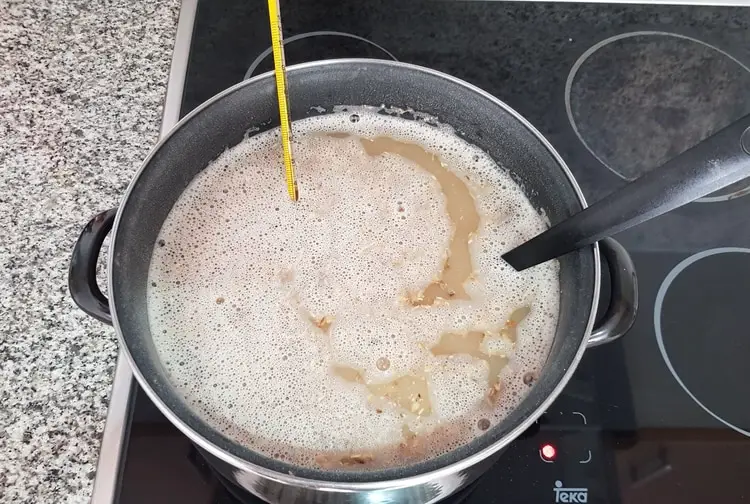
In general, warmer mashing temperatures lead to lower alcohol content.
This is because complex sugars won’t be broken down at higher temperatures, meaning those sugars are not available for fermentation.
A cool mash (143 – 150° F / 61 – 65 ° C) gives you more fermentable sugars, raising the alcohol content a bit and reducing sweetness.
Mash temperatures also affect how much body you have in the final product, so be sure you balance that with your desire to increase the alcohol content.
A low-temperature mash will result in little body and minimal sweetness, which may not be to everyone’s taste.
Most recommendations for mash temperature are 150 – 158° F / 65 – 70° C, for a balance of body and ABV.
Changes to the mash temperature can increase or decrease your final alcohol content by 1%-2%, so be sure to monitor carefully during this step.
10) Fermenting Beer Longer
Does fermenting beer longer make it stronger?
The longer you allow fermentation to continue, the more sugar will be converted into alcohol. Longer fermentation time results in a beer that’s drier and has a higher ABV.
The length of recommended fermentation time will be different depending on the type of beer you’re brewing.
Darker beers and high alcohol content beers will need longer than light brews, while beers that rely on fresh flavors from volatile compounds should not be given a long fermentation time.
In fact, if you intend to brew a beer with a high ABV (above 7%), you should be prepared to wait a while.
The secondary fermentation time for high alcohol beers can be one year or longer. The lengthy wait will improve the flavor at the same time as increasing the alcohol content, but brewers who are anxious to taste their results might have a hard time waiting for it to be ready for bottling.
Things to Consider with Higher Alcohol Content
It can be fun to experiment with ABV levels, but as you increase the alcohol content in a homebrew beer, there are a few additional considerations you should be aware of.
Changing your original recipe will change the process and results, sometimes in unexpected ways.
Here are a couple of things you should keep in mind as you make your plans for brewing a high alcohol beer.
High Alcohol Beer May Take Longer to Carbonate
After taking steps to raise the alcohol content in your beer, you may notice that it doesn’t carbonate as quickly as previous batches.
That’s likely because your yeast has been stressed due to the higher level of alcohol, and it no longer has sufficient energy to create the carbonation.
In other words, a beer with a higher ABV will usually take longer to carbonate.
One option is just to wait and see if the yeast become active given time. Some homebrewers recommend swirling the bottles periodically to “wake up” the yeast, while others say there’s no benefit to this practice.
That’s why most brewers recommend adding fresh yeast when bottling, along with some fermentable sugars, so you’ll be more likely to get the desired result.
If your ABV is above 10%, you’ll want to choose a high alcohol tolerance yeast; for levels below that, you can use a typical ale or lager strain of yeast.
If you fail to add more yeast at the bottling step, you could be waiting months for carbonation to occur, and it might not happen at all.
Increasing Alcohol Content Can Make Beer Thinner
You may notice that many of the adjunct sugars mentioned above have the side effect of decreasing the body of the beer.
When you add a type of sugar that ferments off entirely, contributing only alcohol but not color or flavor, you’re bound to end up with a thinner beer since ethanol has less body than water.
In general, adjunct sugars shouldn’t make up any more than 20% of fermentables since there’s a danger of your beer ending up too thin.
You can avoid this by using malt extracts instead of syrups or sugar to provide a better mouthfeel and body.
How Strong Can I Make My Beer?
It’s certainly possible to brew high alcohol content beers at home.
For most homebrewers, an alcohol content between 5% and 10% will satisfy the quest to challenge their limits with a drinkable result, although some will want to experiment with even higher ABV.
Most of the tips presented here will raise the ABV by a maximum of a few percentage points above the baseline of your original recipe.
If you’re looking to push your alcohol content even further, I’d recommend you start with a method that is explicitly designed to brew a high alcohol beer.
This article provides some specific brewing techniques for brewing strong beer.
Think through what you want your finished beer to be.
You can make a high alcohol beer that has a flavor profile anywhere from light and refreshing to warming and malt-forward, but the ingredients are going to be quite different on either end of the spectrum.
Once you’ve decided what profile and alcohol content you want to achieve, it should be easy to find a recipe that fits those specifications or can be easily tweaked.
Conclusion
If your goal is to increase the alcohol content of your homebrew, keep the methods mentioned above in mind.
However, here are a few final tips to remember for the best results:
- Be sure you maintain good temperature control throughout the brewing process. Don’t allow for extreme variations in temperature, which can damage or kill off yeasts.
- As with any experiment, it’s best to adjust just one variable at a time from your original recipe so you can accurately measure the differences in your final product. Don’t forget to take detailed notes throughout the process so you’ll have correct measurements to calculate your ABV, and so that you don’t forget details when it’s time to brew the next batch.
- Keep samples from each batch you brew, for comparison purposes. It may be hard to remember specific characteristics from a previous batch, even with your notes, so it’s good to be able to taste-test them together.
- If your main goal is just to increase alcohol content and make your beer stronger, you can easily do that by adding sugar in almost any form. The art and skill of home brewing involve finding the correct balance of flavors, color, body, and alcohol content that appeals to you and your audience most.
